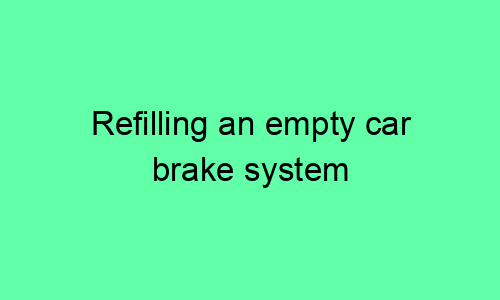## Refilling an Empty Car Brake System: A Step-by-Step Guide
### Introduction
Ensuring your car’s brake system is adequately filled with brake fluid is crucial for maintaining optimal braking performance and safety. If your brake fluid reservoir appears empty or you experience spongy brake pedal feel, it’s imperative to refill the system immediately. Here’s a comprehensive guide to help you refill an empty car brake system safely and effectively.
### Materials You’ll Need
* Brake fluid (check your vehicle’s owner’s manual for the recommended type)
* Funnel
* Rags or paper towels
* Wrench or socket wrench
* Safety glasses
### Step 1: Safety Measures
* Park your car on a level surface and engage the parking brake.
* Wear safety glasses to protect your eyes from potential spills or splashes.
### Step 2: Locate the Brake Fluid Reservoir
* Open your vehicle’s hood.
* Locate the brake fluid reservoir, which is typically a translucent plastic container with a cap that has a brake symbol or the words “Brake Fluid.”
### Step 3: Check Fluid Level
* Remove the reservoir cap cautiously and inspect the brake fluid level.
* If the fluid is below the “MIN” mark on the reservoir, it needs to be refilled.
### Step 4: Add Brake Fluid
* Using a clean funnel, carefully pour the recommended brake fluid into the reservoir until it reaches the “MAX” mark.
* Avoid overfilling, as this can lead to potential brake system issues.
### Step 5: Bleed the System
* Bleeding the brake system is necessary to remove any air that may have entered during the refill process.
* Refer to your vehicle’s owner’s manual for specific bleeding instructions, as the procedure may vary depending on the car model.
* The bleeding process typically involves using a wrench or socket wrench to loosen and tighten a bleeder screw located on each brake caliper while applying pressure on the brake pedal.
### Step 6: Refill and Top Up
* After bleeding the brakes, check the brake fluid level again.
* If the fluid level has dropped, refill it as necessary.
* Repeat the bleeding process if air bubbles are still present.
### Step 7: Test the Brakes
* Start your vehicle and apply light pressure to the brake pedal.
* The pedal should feel firm and responsive.
* If the pedal feels spongy or soft, there may still be air in the system, and further bleeding is required.
### Step 8: Check for Leaks
* After refilling and bleeding the brake system, inspect for any leaks around the reservoir, lines, or calipers.
* Clean up any spilled brake fluid immediately, as it can be corrosive.
### Step 9: Final Steps
* Replace the reservoir cap securely.
* Dispose of used rags or paper towels properly.
* If the brake fluid level continues to drop, consult a professional mechanic to investigate any underlying issues.
### Conclusion
Refilling an empty car brake system requires careful attention and following the steps outlined above. By ensuring proper brake fluid levels and bleeding the system, you can maintain optimal braking performance and enhance your vehicle’s safety. Regular brake fluid checks and timely refills are essential for preventing potential brake failures and keeping you and your passengers safe on the road.






